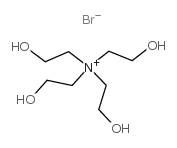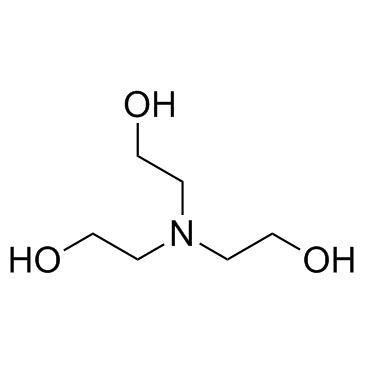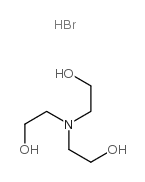4328-04-5
| 英文名 | Tetrakis-(2-hydroxyethyl)ammonium bromide |
|---|---|
| 英文别名 |
tetraethanolammonium bromide
TETRAKIS(2-HYDROXYETHYL)AMMONIUM BROMIDE MFCD00041988 EINECS 224-362-6 |
| 熔点 | 191ºC |
|---|---|
| 分子式 | C8H20BrNO4 |
| 分子量 | 274.15300 |
| 精确质量 | 273.05800 |
| PSA | 80.92000 |
| 储存条件 | 密封储存,储存于阴凉、干燥的库房。 |
| 稳定性 | 常温常压下稳定,避免与不相容材料接触。与强氧化剂反应。 |
| 分子结构 | 1、摩尔折射率:无可用的 2、摩尔体积(cm3/mol):无可用的 3、等张比容(90.2K):无可用的 4、表面张力(dyne/cm):无可用的 5、介电常数:无可用的 6、极化率(10-24cm3):无可用的 7、单一同位素质量:273.057563Da 8、标称质量:273Da 9、平均质量:274.1527Da |
| 计算化学 | 1、 疏水参数计算参考值(XlogP): 2、 氢键供体数量:4 3、 氢键受体数量:5 4、 可旋转化学键数量:8 5、 互变异构体数量: 6、 拓扑分子极性表面积(TPSA):80.9 7、 重原子数量:14 8、 表面电荷:0 9、 复杂度:91.2 10、 同位素原子数量:0 11、 确定原子立构中心数量:0 12、 不确定原子立构中心数量:0 13、 确定化学键立构中心数量:0 14、 不确定化学键立构中心数量:0 15、 共价键单元数量:2 |
| 更多 | 1. 性状:白色结晶性粉末 2. 密度(g/mL,20℃):未确定 3. 相对蒸汽密度(g/mL,空气=1):未确定 4. 熔点(ºC):191 5. 沸点(ºC,常压):未确定 6. 沸点(ºC,1mmHg):未确定 7. 折射率(n20/D):未确定 8. 闪点(ºC):未确定 9. 比旋光度(º):未确定 10. 自燃点或引燃温度(ºC):未确定 11. 蒸气压(mPa,20ºC):未确定 12. 饱和蒸气压(kPa,25ºC):未确定 13. 燃烧热(KJ/mol):未确定 14. 临界温度(ºC):未确定 15. 临界压力(KPa):未确定 16. 油水(辛醇/水)分配系数的对数值:未确定 17. 爆炸上限(%,V/V):未确定 18. 爆炸下限(%,V/V):未确定 19. 溶解性:未确定 |
Synonym:Ethanaminium,2-Hydroxy-N,N,N-Tris(2-Hydroxyethyl)-, Bromide Section 2 - COMPOSITION, INFORMATION ON INGREDIENTS
Risk Phrases: None Listed. Section 3 - HAZARDS IDENTIFICATION EMERGENCY OVERVIEW
The toxicological properties of this material have not been fully investigated. Potential Health Effects Eye: May cause eye irritation. Skin: May cause skin irritation. Ingestion: May cause irritation of the digestive tract. The toxicological properties of this substance have not been fully investigated. Inhalation: May cause respiratory tract irritation. The toxicological properties of this substance have not been fully investigated. Chronic: No information found. Section 4 - FIRST AID MEASURES Eyes: Flush eyes with plenty of water for at least 15 minutes, occasionally lifting the upper and lower eyelids. Get medical aid. Skin: Get medical aid. Flush skin with plenty of water for at least 15 minutes while removing contaminated clothing and shoes. Wash clothing before reuse. Ingestion: Never give anything by mouth to an unconscious person. Get medical aid. Do NOT induce vomiting. If conscious and alert, rinse mouth and drink 2-4 cupfuls of milk or water. Inhalation: Remove from exposure and move to fresh air immediately. If not breathing, give artificial respiration. If breathing is difficult, give oxygen. Get medical aid. Notes to Physician: Section 5 - FIRE FIGHTING MEASURES General Information: As in any fire, wear a self-contained breathing apparatus in pressure-demand, MSHA/NIOSH (approved or equivalent), and full protective gear. During a fire, irritating and highly toxic gases may be generated by thermal decomposition or combustion. Runoff from fire control or dilution water may cause pollution. Extinguishing Media: Use agent most appropriate to extinguish fire. Use water spray, dry chemical, carbon dioxide, or appropriate foam. Section 6 - ACCIDENTAL RELEASE MEASURES General Information: Use proper personal protective equipment as indicated in Section 8. Spills/Leaks: Vacuum or sweep up material and place into a suitable disposal container. Clean up spills immediately, observing precautions in the Protective Equipment section. Avoid generating dusty conditions. Provide ventilation. Section 7 - HANDLING and STORAGE Handling: Wash thoroughly after handling. Remove contaminated clothing and wash before reuse. Use with adequate ventilation. Minimize dust generation and accumulation. Avoid contact with eyes, skin, and clothing. Keep container tightly closed. Avoid ingestion and inhalation. Storage: Keep container closed when not in use. Store in a tightly closed container. Store in a cool, dry, well-ventilated area away from incompatible substances. Section 8 - EXPOSURE CONTROLS, PERSONAL PROTECTION Engineering Controls: Facilities storing or utilizing this material should be equipped with an eyewash facility and a safety shower. Use process enclosure, local exhaust ventilation, or other engineering controls to control airborne levels. Exposure Limits CAS# 4328-04-5: Personal Protective Equipment Eyes: Wear appropriate protective eyeglasses or chemical safety goggles as described by OSHA's eye and face protection regulations in 29 CFR 1910.133 or European Standard EN166. Skin: Wear appropriate protective gloves to prevent skin exposure. Clothing: Wear appropriate protective clothing to minimize contact with skin. Respirators: Follow the OSHA respirator regulations found in 29 CFR 1910.134 or European Standard EN 149. Use a NIOSH/MSHA or European Standard EN 149 approved respirator if exposure limits are exceeded or if irritation or other symptoms are experienced. Section 9 - PHYSICAL AND CHEMICAL PROPERTIES Physical State: Crystalline powder Color: almost white Odor: Not available. pH: Not available. Vapor Pressure: Not available. Viscosity: Not available. Boiling Point: Not available. Freezing/Melting Point: 191 deg C Autoignition Temperature: Not available. Flash Point: Not available. Explosion Limits, lower: Not available. Explosion Limits, upper: Not available. Decomposition Temperature: Solubility in water: Specific Gravity/Density: Molecular Formula: C8H20BrNO4 Molecular Weight: 274.15 Section 10 - STABILITY AND REACTIVITY Chemical Stability: Stable under normal temperatures and pressures. Conditions to Avoid: Incompatible materials, dust generation, excess heat, strong oxidants. Incompatibilities with Other Materials: Oxidizing agents. Hazardous Decomposition Products: Carbon monoxide, irritating and toxic fumes and gases, carbon dioxide, hydrogen bromide. Hazardous Polymerization: Has not been reported Section 11 - TOXICOLOGICAL INFORMATION RTECS#: CAS# 4328-04-5 unlisted. LD50/LC50: Not available. Carcinogenicity: Tetrakis(2-Hydroxyethyl)Ammonium Bromide - Not listed by ACGIH, IARC, or NTP. Section 12 - ECOLOGICAL INFORMATION Section 13 - DISPOSAL CONSIDERATIONS Dispose of in a manner consistent with federal, state, and local regulations. Section 14 - TRANSPORT INFORMATION IATA Not regulated as a hazardous material. IMO Not regulated as a hazardous material. RID/ADR Not regulated as a hazardous material. Section 15 - REGULATORY INFORMATION European/International Regulations European Labeling in Accordance with EC Directives Hazard Symbols: Not available. Risk Phrases: Safety Phrases: S 24/25 Avoid contact with skin and eyes. WGK (Water Danger/Protection) CAS# 4328-04-5: No information available. Canada CAS# 4328-04-5 is listed on Canada's NDSL List. CAS# 4328-04-5 is not listed on Canada's Ingredient Disclosure List. US FEDERAL TSCA CAS# 4328-04-5 is listed on the TSCA inventory. SECTION 16 - ADDITIONAL INFORMATION N/A |
| 安全声明 (欧洲) | 24/25 |
|---|---|
| 海关编码 | 2923900090 |
|
~% 
4328-04-5 |
| 文献:JORDAN, Roy, Arlington Patent: WO2008/155520 A2, 2008 ; Location in patent: Page/Page column 12 ; |
|
~% 
4328-04-5 |
| 文献:I.G.Farbenind. Patent: US2173069 , 1937 ; Full Text Show Details I.G.Farbenind. Patent: US2137314 , 1936 ; Full Text Show Details I.G.Farbenind. Patent: FR806616 ; Full Text Show Details I.G.Farbenind. Patent: DE719817 , 1935 ; DRP/DRBP Org.Chem. Full Text Show Details Prod.Amines Soc.An. Patent: DE655882 , 1931 ; Fortschr. Teerfarbenfabr. Verw. Industriezweige, vol. 22, p. 723 Full Text Show Details I.G.Farbenind. Patent: DE681523 , 1934 ; |
|
~% 
4328-04-5 |
| 文献:Prelog; Blazek Collection of Czechoslovak Chemical Communications, 1934 , vol. 6, p. 484 |
| 上游产品 4 | |
|---|---|
| 下游产品 0 | |
| 海关编码 | 2923900090 |
|---|---|
| 中文概述 | 2923900090 其他季铵盐及季铵碱。监管条件:无。增值税率:17.0%。退税率:9.0%。最惠国关税:6.5%。普通关税:30.0% |
| 申报要素 | 品名, 成分含量, 用途 |
| Summary | 2923900090 other quaternary ammonium salts and hydroxides。Supervision conditions:None。VAT:17.0%。Tax rebate rate:9.0%。MFN tariff:6.5%。General tariff:30.0% |




